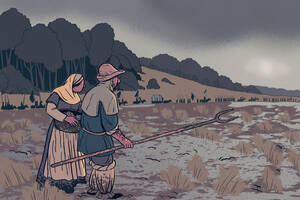
Riley Mann
Government stimuli, central bank interventions, and the rollout of vaccines made 2021 a snapback year, following the shutdowns and mass layoffs that had led to a quick, deep recession in 2020. Now, the current economy is unprecedented, with strong growth, rapidly falling unemployment, and high inflation, but also a rapidly rising money supply, growing government debt, and an ongoing pandemic.
Economic growth is forecasted to be on track to close 2021 at an above-average pace, with real GDP expected to increase by 5.5 percent for the year. As we move into 2022, the pace of real economic growth is expected to moderate, with a current consensus projection of 3.9 percent. Questionably, most forecasters are predicting future growth to slowly revert to pre-pandemic levels by 2023 or 2024.
With inflation running rampant, the big question is whether real GDP growth could turn negative on a quarterly basis in 2022. This is absolutely possible. Given that the third-quarter real growth rate was only 0.6 percent on a quarterly basis, real GDP growth could turn negative for parts of 2022, while nominal GDP will most likely continue a positive trajectory.
Much uncertainty surrounds the strength and pace of economic growth for 2022. Here are the top five economic concerns for next year and how they could potentially play out.
Uncertain Federal Reserve Policy
The largest risk facing the global economy in the coming year is the policies of the Federal Reserve with regards to managing inflation. As I discussed previously, it remains to be seen if inflation is a temporary phenomenon, mitigating in 2022 as the Federal Reserve projects, or if we are entering a sustained period of escalating prices.
Inflation today is driven by complex factors, beyond disrupted supply chains and increased consumer spending. One cannot understand current inflation without taking into account the growth in the U.S. money supply.
While we can debate the causes and consequences of current inflation, there is little doubt the solution lies with the Federal Reserve and its Chairman, Jerome Powell. The only policy that the White House might implement to slow down inflation would be raising taxes.
Although the Fed continues to view inflation as being the byproduct of excess demand and supply disruptions, such discussion does not point to a solution. The Fed’s decision to taper its bond-buying program is a first step, but unlikely to be sufficient. The Fed will ultimately need to reverse its bond-buying program, pushing interest rates higher in the process and possibly stalling economic growth.
The Covid-19 Pandemic Drags On
Global economies are still subject to the shockwaves caused by the initial rout of Covid-19. Because the proportion of unvaccinated people remains high, and given the weakening effects of the vaccines and the growth of new variants, Covid-19 cases continue to spike around the globe, creating new economic shocks, which will continue into 2022 and possibly even longer.
Covid-19 is of particular concern in developing countries—because of a lack of vaccine availability. As I noted before, the U.S. is not doing enough to distribute and provide for deprived countries around the world. Not only is this a humanitarian issue, but it could also disrupt supply chains if spiking Covid cases in certain economies spread around the world, further disrupting production and generating inflation.
Labor Shortages Will Continue
While job growth continues to be very strong, the issue is a tight labor supply with more than 10 million job openings in the latest Bureau of Labor Statistics report but only 7.4 million unemployed. This is compounded by the fact that five million people have left the U.S. job market since the pandemic began; in addition, a record 4.4 million people voluntarily left their jobs in September.
Global economies are still subject to the shockwaves caused by the initial rout of Covid-19.
If this imbalance persists, it will hurt productivity and, over time, undermine economic growth. Workers have been hesitant to rejoin the workforce during the pandemic and, with an aging population, retirements are up.
Against this backdrop, those who do change jobs are often able to secure higher pay, resulting in the recent largest increase in wages recorded over a 20-year period. These wage hikes are contributing to rising input costs causing companies to raise output prices, feeding the current inflation rate—itself, an economic concern.
Supply Chain—Beyond the Logjam
Given the recurrent threats of Covid-19, snarls in the supply chain might not be resolved in 2022, which is bad news for businesses and consumers alike. Beyond the current supply-chain disturbances, there are deeper supply-chain issues that must be addressed by companies in every industry: where to source and produce, and how to distribute around the world.
The supply-change problems began with the outbreak of the pandemic when production in Wuhan, China, was shut down. As a result, some companies started shifting production regionally, such as from China to Vietnam.
Rethinking supply chains, however, is broader than one country or region.
Companies need to consider how much of their supply chain should be international versus domestic to mitigate future production and supply-chain problems. But one thing remains clear: supply-chain problems now and in the future can hurt the economy by decreasing supplies and thereby escalating the cost of goods.
U.S.–China Relations and Political Instability
Of critical importance to global business is the relationship between the U.S. and China. While tensions rose in the last administration, there was hope for improvement by now. Unfortunately, tensions have not relaxed. Instead, with President Xi Jinping’s rising power, regional and global threats from China are also rising.
One only need look at the Taiwan issue— if either side presses the point on Taiwan, tensions could escalate, impacting trade and the global economy, as well as the geopolitical landscape.
What the U.S. cannot do, which it has typically done in the past, is ignore the risks posed by China’s expansions into the South China Sea and beyond. Now, more than ever, it is important that the U.S. and its allies stay united in confronting China.
An Obscured View
Where economic growth and inflation will net out in 2022 remains uncertain due to the size, complexity, and uncertainty of the problems to be faced next year. There are large risks of negative consequences ultimately materializing if the Fed fails to react appropriately to the current rise in inflation.
These factors, coupled with the continued threat of the pandemic and rising global political tensions, indicate a lot of risk and uncertainty in the economic climate, which business leaders must manage. The solutions are both local and global, requiring business leaders to remain agile, while thinking strategically for the future.
*
This article originally appeared in Forbes.



